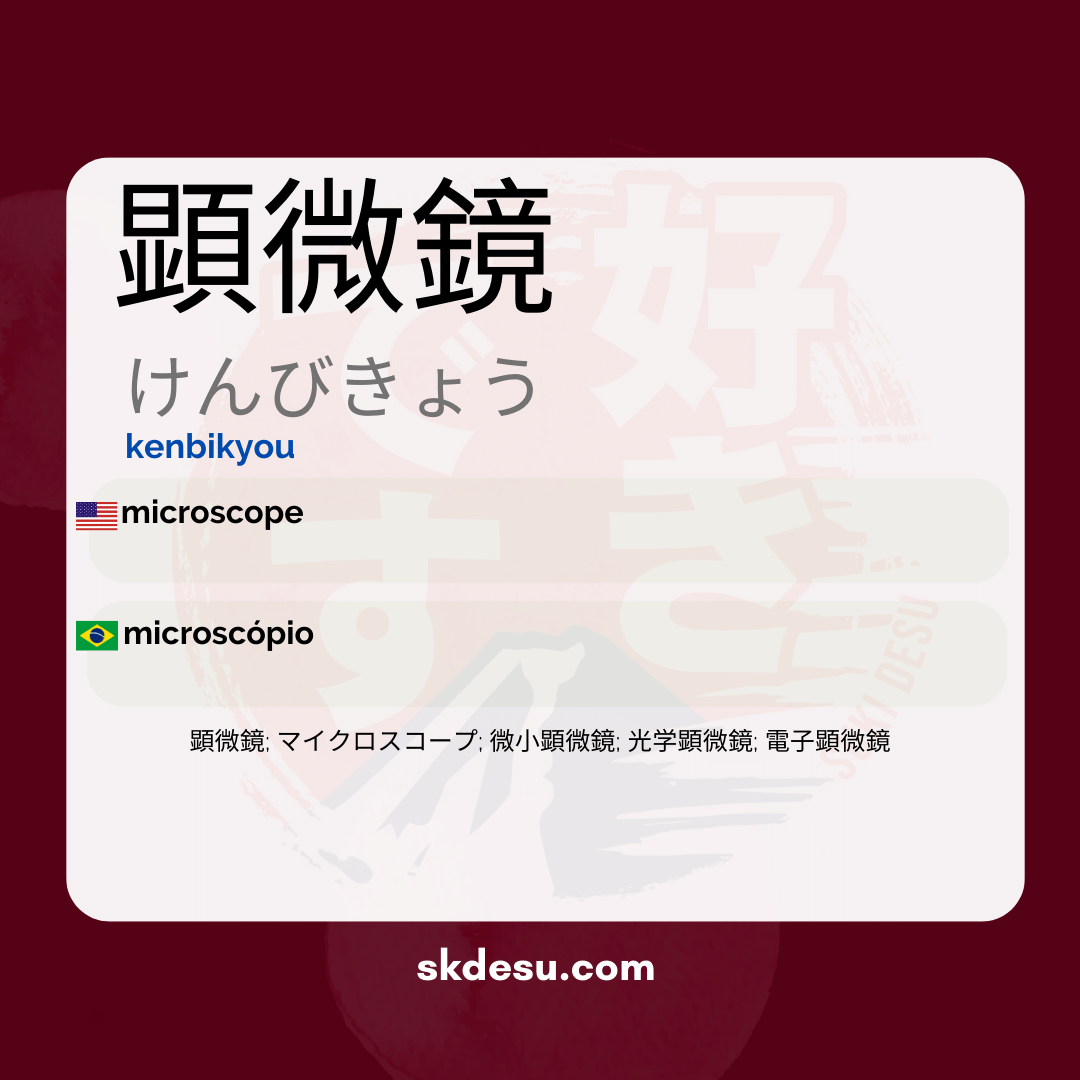Translation and Meaning of: 顕微鏡 - kenbikyou
The Japanese word 顕微鏡[けんびきょう] may seem complex at first glance, but its meaning is quite familiar to anyone who has studied science. In this article, we will explore its literal translation, its everyday use in Japan, some curiosities about its origin, and how to memorize it efficiently. If you are learning Japanese or simply interested in the language, understanding terms like this can enhance your vocabulary and your connection to Japanese culture.
Meaning and translation of 顕微鏡 (kenbikyou)
顕微鏡, read as "kenbikyō", is the Japanese word for "microscope". It is composed of three kanji: 顕 (ken, "visible" or "manifest"), 微 (bi, "small" or "minute") and 鏡 (kyō, "mirror" or "lens"). Together, these characters form an accurate description of the object: an instrument that makes extremely small things visible.
Although the direct translation is simple, it is worth noting that the term is used exactly as in Portuguese, both in scientific contexts and in everyday life. If you visit a laboratory in Japan or watch an anime with a school theme, you will likely come across this word.
Origin and history of the term
The word 顕微鏡 was created during the Meiji period (1868-1912), when Japan underwent intense modernization and the importation of Western scientific terms. Like many technical words in modern Japanese, it follows the kanji composition pattern to describe new concepts, maintaining the logic of classical Chinese language.
Interestingly, the microscope was introduced to Japan by the Dutch in the 18th century, long before the term kenbikyō was created. Initially, the instrument was referred to by longer descriptions or by the Dutch term "microscoop," adapted to ミクロスコープ (mikurosukōpu). The version with kanji only became established when scientific terminology was standardized.
How to memorize and use 顕微鏡
For those learning Japanese, a good strategy is to break down the word into its constituent kanji. The radical 見 (to see) present in 顕, combined with the idea of "small" (微) and "lens" (鏡), creates an easy mental image to associate with the real object. Some students find it helpful to think of it as "lens to see the tiny manifested."
In practice, you will use 顕微鏡 exactly as you would use "microscope". For example: 顕微鏡で細胞を観察する (Kenbikyō de saibō o kansatsu suru) means "to observe cells under the microscope". The word frequently appears in academic, medical, and even science fiction manga contexts.
Vocabulary
Expand your vocabulary with related words:
Synonyms and similar words
- 顕微鏡 (Kenbikyō) - Microscope, usually referring to a conventional optical microscope.
- マイクロスコープ (Maikurosukōpu) - The English term for microscope, often used interchangeably with 顕微鏡.
- 微小顕微鏡 (Bishō Kenbikyō) - Microscope for observing very small structures, designed for small samples.
- 光学顕微鏡 (Kōgaku Kenbikyō) - Optical microscope uses glass lenses to magnify the image of objects.
- 電子顕微鏡 (Denshi Kenbikyō) - Electron microscope uses beams of electrons to obtain high-resolution images.
Related words
Romaji: kenbikyou
Kana: けんびきょう
Type: noun
L: jlpt-n2
Translation / Meaning: microscope
Meaning in English: microscope
Definition: Optical equipment to enlarge and observe tiny objects.
Quick Access
- Vocabulary
- Writing
- Sentences
How to Write in Japanese - (顕微鏡) kenbikyou
See below a step-by-step guide on how to write the word by hand in Japanese. (顕微鏡) kenbikyou:
Example Sentences - (顕微鏡) kenbikyou
See below some example sentences:
Nenhum resultado encontrado.
Other Words of this Type: noun
See other words from our dictionary that are also: noun
ishou
whole life; an entire life; throughout life; an existence; a generation; one age; the whole world; the age.

